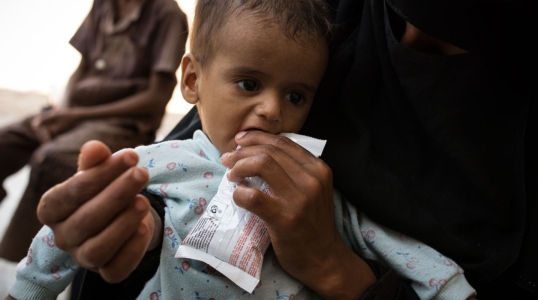Hawo Abdi’s Story
Communities in rural Somalia make their living through agriculture and raising livestock: 80 percent of the population depends on small-scale farming to survive. Many are nomadic pastoralists, raising livestock and moving seasonally to find pasture with their herds. But after season after season of failed rains in a row, there is no longer any pasture to be found, and animals are dying. Two years of intense drought, combined with conflict, poverty, and weak infrastructure, have pushed the country into a massive hunger emergency that threatens to become a famine.
A normal rainy season consists of steady, daily rains for two to three months, but this entire season, parts of the country have received just five days of rain. The primary rainy season—the one families were counting on for the health of their crops and livestock—is failing. Across Somalia, crop production is 90 percent below what it would be in a normal year. Communities desperate for relief are facing a terrifying fact: there is not enough water to keep animals, crops, or people alive.
Large numbers of people in rural areas have been left with no choice but to abandon their homes and trek long distances to towns or cities in search of food and water. Since November, an estimated 615,000 people have been displaced, and that number grows every day. Traveling in remote southern Somalia can mean putting your life at risk: it’s long and especially difficult for families with young children and facing violence from armed groups along the way is a real possibility.
Hawo Abdi, a 29-year-old widow and mother of five children, was a farmer whose arid lands suffered from the severe drought. She told us:
Back home, I had a farm where we grew maize for the family to eat—and we always had enough to eat. But the rains failed for four seasons; we could not cope anymore.
Hawo’s baby son, Ali, became emaciated and severely malnourished. He was not even six months old.
“I didn’t know where to go or what to do. I felt like I failed as a mother. But another mother told me to go to the stabilization center because she had a child who sick for the same reason and got treatment. So I ran here as fast as I could,” says Hawo.
Action Against Hunger, with support from UKAid, runs an emergency nutrition stabilization center in Hodan, Mogadishu, which provides urgent treatment for children suffering from severe acute malnutrition. Some children, like Hawo’s son Ali, are so ill they require intensive, inpatient care in the stabilization center to save their lives. Other children, whose cases are not as severe or advanced, can be treated with lifesaving outpatient care with weekly monitoring and follow up.
To Hawo’s relief, Ali was immediately admitted to the stabilization center. Hawo was still nursing Ali, who was not old enough to eat solid food, but because Hawo was not getting adequate food and water herself, and had also experienced stress and trauma, her body was not producing enough milk. When Action Against Hunger’s nutrition specialists assessed Ali, he was so ill he had no appetite, and he was not able to swallow. They admitted him for inpatient care, and treated him with special therapeutic milk designed for severely malnourished children under the age of six months. Ali is responding well and, each day, he gets stronger and healthier.
We don’t have a good shelter. We use pieces of cloth and small plastic bags to cover the roof. I worry that my other children will get sick.
Our top priority is to provide lifesaving treatment for severely malnourished children and to protect the health of vulnerable pregnant women and nursing mothers. We are ready to assist more than 200,000 people in our initial emergency response. In some areas within Somalia, Action Against Hunger is the only organization providing assistance to communities.






